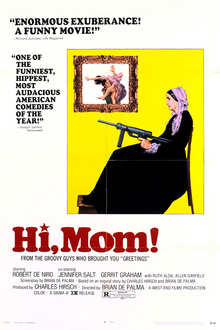Released in 1970, Hi, Mom!, tells the story of Jon Rubin (played by a 26 year-old Robert De Niro). The somewhat spacey and kind of creepy Jon has just returned to New York City from Vietnam. After moving into a run-down apartment building and meeting the building’s superintendent (Charles Durning), Jon is hired to direct a pornographic film by producer Joe Banner (Allen Garfield). Jon’s idea to simply point his camera at his building and to film his neighbors as they go about their day. As quickly becomes apparent, Jon is mostly just looking for an excuse to watch and film Judy Bishop (Jennifer Salt).
Also living in the building is Gerrit Wood (Gerrit Graham), who is first seen triumphantly putting posters of Che Guevara and Malcolm X up in his apartment. Gerrit is a freshly-minted political radical and the leader of a group of performance artists who put on a show called Be Black, Baby, in which the white audience members are forced to wear blackface and are then chased, attacked, and assaulted by black actors wearing whiteface. (Gerrit himself is white.) Jon is hired to play the police officer who beats and arrests the members of the audience at the end of the performance. Of course, eventually, the real police show up….
An attempt at an episodic counter-culture comedy, Hi, Mom is definitely a product of the time in which it was made, both in its style and its thematic content. Today, it’s best-known for being one of Brian De Palma’s early independent films and for featuring Robert De Niro in one of his first starring roles. De Palma and De Niro aren’t exactly the first names that come to mind when one thinks about comedy and Hi, Mom shows that there’s a good reason for that. As both a screenwriter who felt he had something important to say and a young director who was obviously eager to show off everything that he could do with a camera, Brian De Palma simply cannot get out of his own way. Scenes are needlessly sped up. Scenes are pointlessly slowed down. The musical cues are obvious. The dialogue is often so broad that it comes across as being cartoonish. One gets the feeling that De Palma didn’t trust the audience to get the jokes so he went overboard to make sure everyone knew when to react. All of the pointless camera trickery serves the same purpose that a laugh track would on an old sitcom. Interestingly enough, the only sequence that really works as satire is the Be Black, Baby sequence and that’s because De Palma directs it in a semi-documentary fashion. De Palma gets out of his own way and allow the sequence to develop a natural rhythm. (Of course, seen today, the scene will bring to mind the upper class white liberals who pay money to have an activist lecture them about their privilege while having their friends over for dinner.)
As for Robert De Niro, he gives a typically nervy performance, one that feels like a dry run for his later work in Mean Streets, Taxi Driver, and King of Comedy. Despite the reputation of those films, there are some genuinely funny moments to be found in all of them. Most of them, like the classic Taxi Driver conversation between De Niro’s Travis and Peter Boyle’s Wizard, are funny because of how people react to De Niro’s obviously unhinged characters. Both Taxi Driver and King of Comedy got mileage out of having normal people try to deal with De Niro’s unstable characters. In Hi, Mom, everyone is equally wacky and, as such, De Niro doesn’t really have anyone to play off. No one is really reacting to anything, De Niro-included. (There is some spark to his scenes with Charles Durning and Allen Garfield but even those scenes seem to drag on forever.)
On the plus side, Hi, Mom! is was shot on the actual streets of New York City, guerilla-style. (A “Re-Elect Mayor Lindsay” sign in the background confirms that the film was made on location in 1969.) When De Palma isn’t getting in his own way with all of his fancy camera tricks, he manages to capture so memorably bleak images of New York City. Hi, Mom! presents New York as being a dirty, crime-ridden, and menacing city but it also captures the odd grandeur of urban decay. At its best, Hi, Mom! captures the love/hate relationship that many seem to have New York City. The city feels both alive and dangerous at the same time. Hi, Mom! is too uneven to work as a sustained satire but, as a documentary about New York at the end of the turbulent 60s, it’s worth watching.
I should mention that this was not the first time that De Palma and De Niro teamed up. Indeed, De Niro was De Palma’s muse even before he met Martin Scorsese. Hi, Mom! was a loose sequel to an earlier De Palma/De Niro film called Greetings. (Like many of De Palma’s future films, both Greetings and Hi, Mom! were originally rated X but later re-rated R.) De Palma and De Niro, of course, would both go onto have long Hollywood careers. (They would later reunite for The Untouchables, a big-budget spectacle of a film that’s about as far from the grungy Hi, Mom! as one can get.) De Palma’s career has had its ups and downs but, as of late, many of his films have been positively reevaluated. As for De Niro, he can finally kind of play comedy. That said, I’d rather watch Hi, Mom than Dirty Grandpa.

Pingback: Lisa Marie’s Week In Review: 4/10/23 — 4/16/23 | Through the Shattered Lens